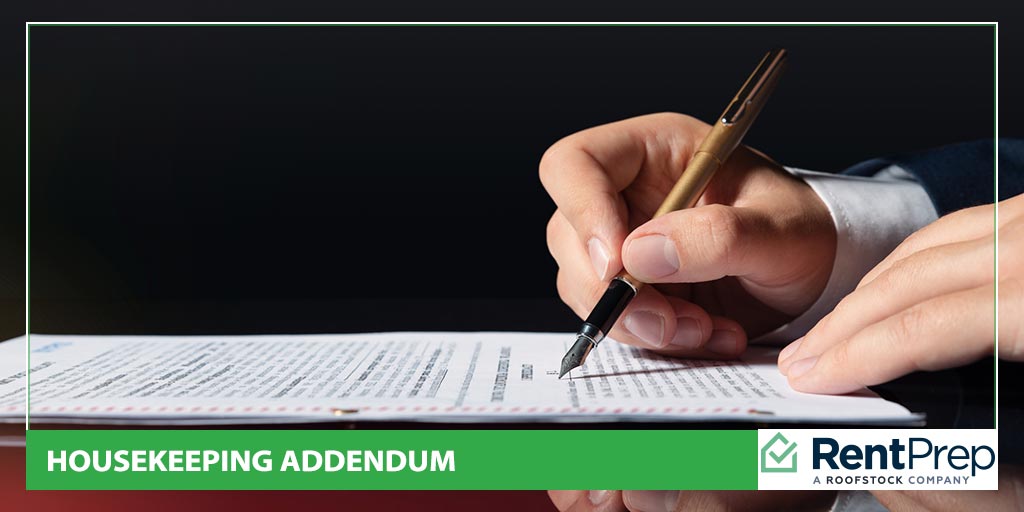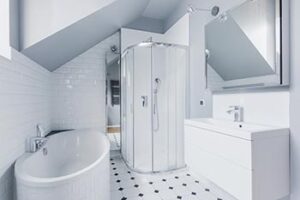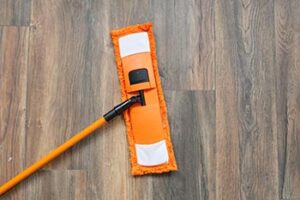
Are you worried about the condition that your properties will be kept in when a tenant is living in them? That’s completely natural. All landlords worry that a new tenant might destroy their property, but the simple fact is that you have to give tenants a chance.
Giving them a chance, however, doesn’t mean that you can’t protect yourself from the potential cost of repairs. There are a number of ways that you can ensure that any damages done to the property, including those caused by not cleaning, will be covered by the tenant.
Have you ever used a housekeeping addendum before? This extra clause can be added to a rental lease to ensure that tenants are aware of how clean they are expected to keep the property. Trust us when we say that this addendum can be a game-changer!
Today, we’ll share how this extra clause can be beneficial as well as a sample housekeeping contract agreement format that you can modify for free.
A Table Of Contents For Housekeeping Agreements
- What Is A Housekeeping Agreement?
- Are Tenants Legally Required To Keep A Property Neat?
- Checking State Regulations On Cleaning Inspections
- Housekeeping Addendum Sample Form
What Is A Housekeeping Agreement?

A housekeeping agreement or addendum is an additional lease clause that is added to a rental lease to alert the tenant about what the cleaning expectations for the property are. Through a set of guidelines, the landlord lets the tenant know exactly which areas of the property need to be maintained.
For example, the agreement might mention that showers and bathtubs need to have mildew buildup regularly removed.
The idea of a housekeeping agreement is to remind tenants that while the property is theirs to use, there will be repercussions if they let it get too dirty or out of hand. Some tenants have never had to clean for themselves before, so it can be very beneficial to make sure that this is all clear from day one.
How Are Housing Addendums Implemented?
If you’ve never used this type of addendum before, you’re probably wondering just how it should work!
Typically, landlords use these addendums as part of their overall inspection and/or renewal process:
- Sign the original rental contract, including the housekeeping paperwork.
- The tenant moves in and carries out lease term.
- When it’s time for a maintenance inspection, you will need to do a housekeeping inspection at the same time.
- If the tenant passes the inspection, allow them to renew their lease if they wish to.
- If they do not pass, you will need to decide whether you end their lease or allow them a chance to make changes.
Many landlords use a 6-month inspection schedule rather than an annual one. This means that halfway through the standard lease, they do an inspection of the property to ensure that basic maintenance and cleaning tasks that the tenant is responsible for are being completed.
It is up to you to decide how frequently you want to do these types of inspections. Inspections every six months can feel excessive, but you will also gain the comfort of knowing that your property is being properly cared for.
Are Tenants Legally Required To Keep A Property Neat?
Though it might pain you to hear this, the fact of the matter is that tenants are not required to be neat. They are not required to fold their laundry, and they can choose to leave their items strewn about on the floor if they want to. Realistically speaking, you cannot do anything about this unless the mess is:
- A health or safety violation
- Causing a health or safety violation for neighboring units
- Breaking any agreed-upon lease addendums
Why is it that the tenants get the final say about how they keep their living space organized?
While renting your property, tenants are considered to be the primary residents. That means that you cannot dictate their every move. Still, you can have some influence on how they treat your property because you are, ultimately, still the property owner.
The tenants are legally required to follow any valid lease terms that they agreed to, so you can instill some level of cleanliness by having them sign a housekeeping agreement when they are first moving in. This type of agreement can ensure that certain problem areas are taken care of, and you will be able to sleep easier at night knowing that those areas won’t be ignored.
Checking State Regulations On Cleaning Inspections

At this point, it is important to note that not every state allows cleaning and maintenance to be inspected, and some have regulations about how those inspections must be handled.
In California, for example, there is a law that severely limits how and when a landlord can access an occupied property, so inspections aren’t typically allowed. Additionally, there are some protections for tenants that are classified as hoarders, as it is a mental illness. If you are dealing with a hoarder situation, find out more here.
Before you determine whether or not you want to start adding housekeeping clauses or addendums to your lease, be sure to do some quick fact-checking and find out if they are permissible or not.
Housekeeping Addendum Sample Form
Now that you’ve got the necessary background information, let’s take a closer look at the housekeeping contract agreement format that we can offer in our sample forms.
Here is the form:
| Housekeeping Addendum |
As you can see, this form isn’t incredibly long, but it does contain a lot of information. Let’s break down each section so that you can determine what needs to be included on your addendum and see where you can make changes to better fit your properties.
Basic Details
As always, this form should start by gathering basic details:
- Date
- Property Address
This identifying information makes it easy to know exactly what property this document refers to even if it is viewed without any context. You always want to be sure that your documentation is clearly labeled so that there is not any confusion.
Housekeeping Standards
The next section should cover all housekeeping standards, inside and outside of the unit. Specifically, this list is telling the tenant what you will inspect when it is time for a housekeeping inspection.
For the inside list, we recommend including at least the following:
- Unit is clean and free of dirt or grease
- Excessive mildew and mold has been removed
- Floors are clean and hazard-free
- Trash is cleaned and removed from unit regularly
- Storage and cleanliness does not contribute to rodent or insect infestations
- Kitchen is grease- and spilled food-free
- Appliances are clean
- Refrigerator is defrosted regularly
- No flammable materials are stored in unit
- Entrance and exit pathways are kept clear
For the outside list, we recommend including at least the following:
- All yard areas are free of trash, debris, furniture, appliances, etc.
- Living room furniture cannot be used or stored on porches unless it is outdoor-friendly
- No graffiti on outdoor walls
- No hanging things on outdoor walls without permission
- Sidewalks are hazard-free
- No inoperative vehicles in parking lot/space
- No feeding of stray animals
This section can be easily adjusted to fit your needs. If some of these topics do not apply to your property, they can be removed. If other unique areas of your property need to be addressed, you can add those.
The key here is to focus on the truly problematic cleaning issues, such as food debris, which can lead to an expensive and dangerous infestation. Don’t worry about including items such as hanging up clothes as this list is not about tidiness but about cleanliness.
Inspection Frequency
Next, let the tenant know how frequently an inspection will occur.
When it is time to do an inspection, you should give your tenant notice of a few days as a courtesy and as required by law. On the day of the inspection, use the list that you provided tenants to give them a pass/fail rating.
Failure Procedure
In this type of addendum, it is important to let the tenant know what the repercussions will be if they fail the inspection, so you will want to detail those steps next.
In our example, we suggest the following:
- A follow-up inspection will occur within two weeks of an original, failing inspection.
- If the until fails again, a third inspection will occur in thirty (30) days.
- If the unit fails the third inspection, the tenant will receive a lease termination notice immediately, and eviction proceedings will begin for non-compliance.
We suggest this policy because it gives tenants a reasonable amount of time to fix their unit’s problems without leaving you stuck with them forever. If a tenant does not or cannot comply with the lease agreement, it is within your rights to terminate their lease and move forward.
Smoke Detectors
Our addendum includes two different (and equally important) notes about smoke detectors.
First, the smoke detector will be checked during the move-in inspection. If it is not working properly, you as the landlord should order a replacement or repair immediately.
In this addendum, the failure of a smoke alarm to work properly at any inspection means an immediate failure of the inspection. This applies only if the tenant is responsible for smoke alarm maintenance. If you are working in a state where you, the landlord, are responsible for checking the alarms, you’ll want to remove this point.
Unable To Inspect
In many apartment complexes, the inspections can happen whether the tenant is home or not. Should you decide to handle inspections in this way, you will want to include a point about doors that are dead-bolted from the inside.
If a door is dead-bolted from the inside and you cannot do the inspection, that inspections should be an automatic fail. You gave notice to the tenant, and they either deliberately or accidentally kept you from inspecting the property. Because of this, they will fail the inspection until you can reinspect it.
Signatures
Finally, the lease addendum should end with the appropriate signatures from all parties involved. This addendum can be signed at the same time as the original lease, or it can be added on at a later time if all parties are in agreement.
Conclusion
Not every landlord uses a housekeeping addendum, but they can be incredibly beneficial for ensuring that your property is being properly maintained. In our experience, this type of form is especially useful for multi-unit buildings when bad conditions in one unit can quickly cause problems in another.
Remember that you need to be mindful of all local and state laws when using this type of form. Otherwise, feel free to modify the sample template that we’ve shared to fit your needs.

